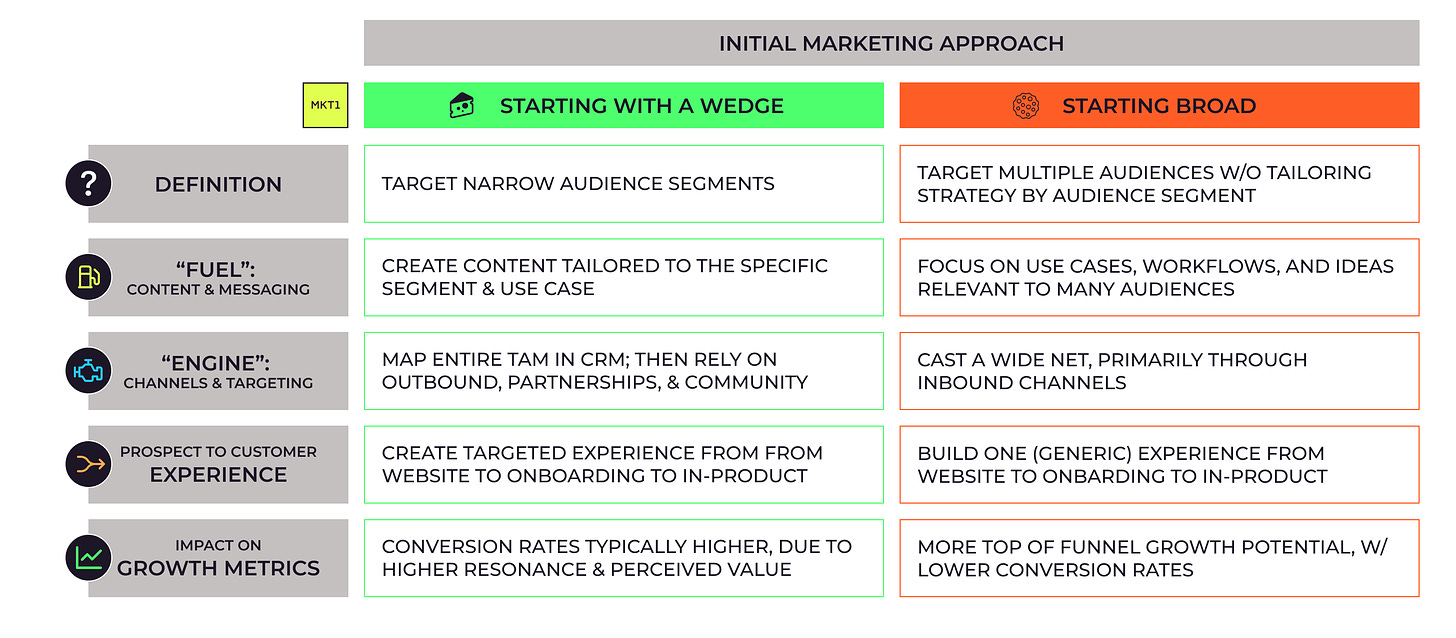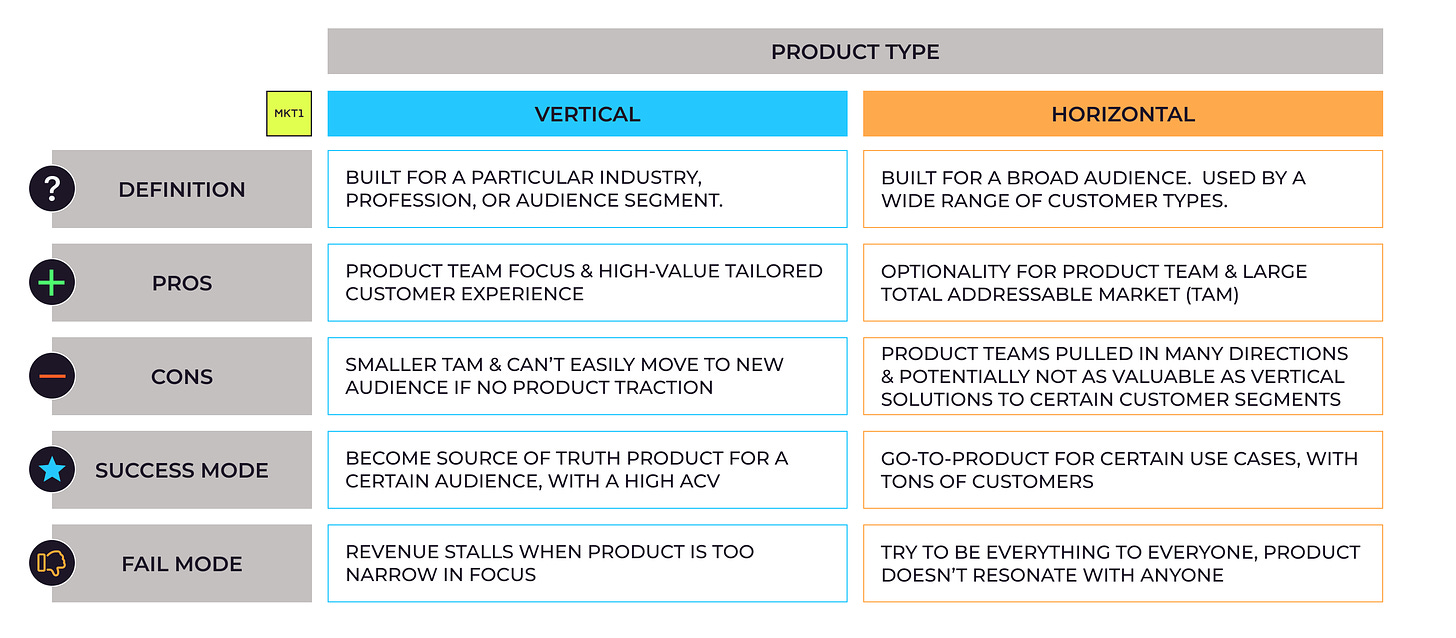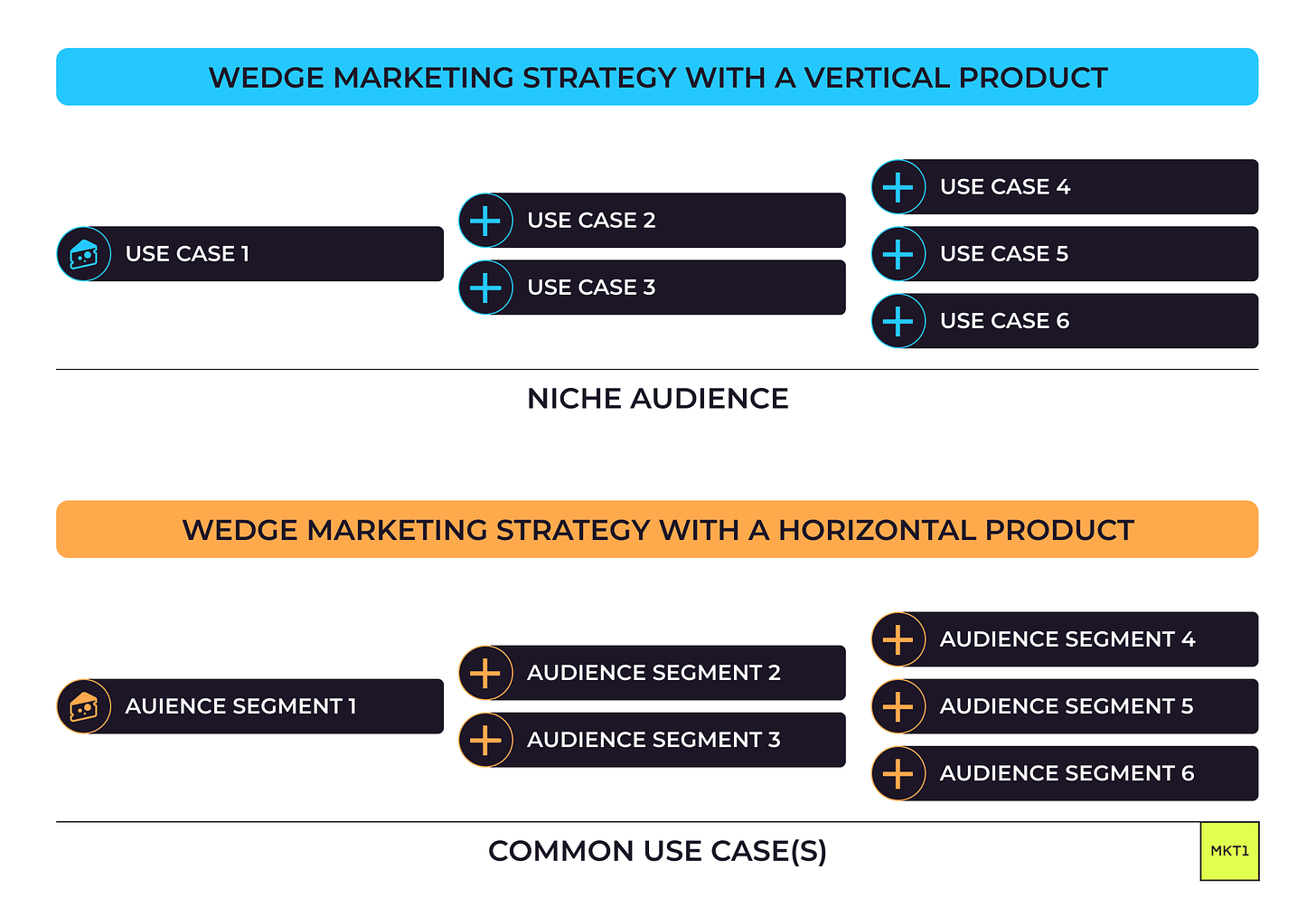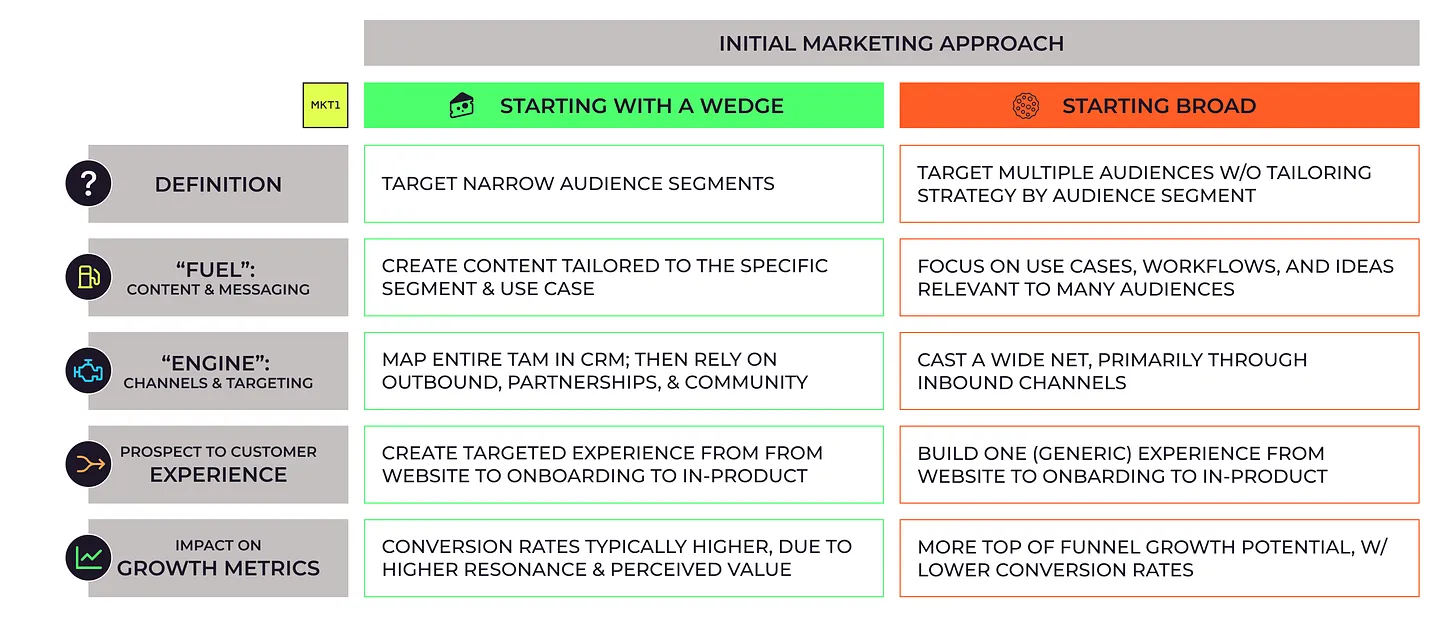It’s time to get specific. Broad and horizontal approaches to marketing no longer work. Maybe they never really did?!
With modern martech (AI, automation, no code tools), your audience now expects personalized, high-value marketing that feels custom built for them. Meaning, early-stage marketing strategies that don’t focus on an acute pain for a specific audience segment will definitely fall flat in 2024.
Given this, we recommend using a wedge marketing approach in the early days, and expanding from this initial niche over time—whether you have a horizontal or vertical product.
This newsletter breaks down:
- 🧀 How to find your initial wedge
- 🪤 How to approach marketing with a wedge strategy
(so stoked to have found a relevant use for this mouse trap emoji: 🪤) - 🥧 How to expand from your initial wedge, and how this differs with horizontal and vertical products
- 🍽️ How to keep track of all of your audiences once you expand–without spreading yourself too thin
Event: Our 2nd “AI showcase” on 3/21
This newsletter speaks to what’s now possible (and necessary) due to modern martech—but sometimes you have to see it to believe it. If you want to see demos from a handful of startups changing how marketers market, come to our 2nd AI showcase on 3/21.
Thanks to our sponsors
We only include sponsors we actually recommend to our community and portfolio companies. If you are interested in sponsoring our newsletter, email us at sponsorships@mkt1.co
Positional – SEO & content marketing toolset
Positional is the toolset for GTM teams looking to start, grow, and scale a content marketing & SEO strategy. Positional goes end-to-end with tools for keyword research, content optimization, and analytics, allowing you to optimize your channel for results — not vanity metrics.
Why MKT1 recommends Positional: Founders Nate & Matt get it. They are 2x Y Combinator alumni who’ve scaled SEO to millions of visitors in the most competitive industries. Positional will help you make the right content for your specific audience segment(s).
Offer: Join Positional’s beta before their public launch on March 26th for discounted pricing, unlimited seats, & usage.
RevenueHero – Lead qualification, routing & scheduling
RevenueHero is the easiest way for marketers to qualify and route leads to sales rep’s calendar, right in your demo request flow, in email sequences, and sales hand-offs. Marketers and sales teams love RevenueHero’s built-in meeting hand-off, routing logs, native integrations with the GTM stack, custom branding, and insights at every step of the conversion funnel.
Why MKT1 recommends RevenueHero: We’ve been recommending RevenueHero since we wrote a newsletter on improving demo request flows last year. Making the marketing-to-sales handoff feel invisible to prospects improves conversion—RevenueHero makes this much easier.
Offer: Learn more about RevenueHero here & mention MKT1 for 15% off if you close by the end of April 2024.
Ten Speed – Organic growth agency
Ten Speed is an organic growth agency for early and growth-stage SaaS companies like Bitly, Workvivo, and Visible. We tie into your marketing strategy, find low-hanging fruit, and grow your awareness, engagement, and MRR with proven SEO strategies and revenue-focused content.
Why MKT1 recommends Ten Speed: We’ve been referring Ten Speed to our portfolio companies for a couple of years now. They build strategies for your startup’s specific needs and understand the value of both fuel and engine.
Offer: Reach out to Ten Speed here & mention MKT1 Newsletter to get $1,000 off your first month.
🧀 What’s a wedge marketing strategy?
We recommend all startups find a wedge to win early users and customers. Even if you have a horizontal product that can serve a broader audience or set of use cases, you need to get specific in your marketing efforts. With a broad approach, your content will fall flat, you’ll spread yourself too thin across channels, and your conversion rates will suffer.
With a wedge marketing strategy, you capture a specific niche (or wedge) first. A niche typically means an audience segment plus use case to start. Once you capture your wedge and are converting prospects from alternative products, services, or processes, you can expand.
To expand, you strategically broaden your reach by capturing more use cases for the same audience (aka land & expand) or by focusing on more audience segments with the same use case(s).

Why a wedge works best
To win the market, you need to find weaknesses in incumbents’ strategies–whether that’s a missing use case or an underserved audience segment. If there is no incumbent, you still need to find acute pain points in the way people currently manage the process, workflow, or problem.
If you’ve truly found a wedge, you can use the first niche to get to the second niche and so on. Meaning, you’ll be able to accelerate growth once you capture the initial wedge.
Founders: Don’t market your pitch deck
Founders often default to starting broad. After all, it’s very tempting for founders to use the same messaging from their investor pitch deck on their website, in marketing assets, and even sales pitches.
What does marketing your pitch deck look like?
- You try to target every audience you plan to ever serve right away
- You talk about your vision, but no one understands what your product does
- You talk about use cases and features you can’t beat your competitors on…yet
This is great for raising money (Big TAM! Big vision!) but is not an effective marketing strategy to gain early traction. Instead, focus on a specific pain point, land with one audience or use case and then expand.
Examples of wedge strategies
Carta – Started with cap table management for founders, expanded to a complete equity management platform for companies and investors.
Toast – Started with booking and reservations software for restaurants, expanded to a complete POS for restaurants and beyond
Stripe – Started with a payments API for developers, expanded to financial infrastructure for the entire internet.
🪤 How a wedge marketing strategy works
- Find a wedge: Find audience segments and/or use cases where your product delivers a 10x better experience. Focus most of your marketing efforts on this.
- Identify all of your prospects in this wedge: Get as many accounts as possible into your CRM, and systematically try to get in front of them. With a narrowed down TAM and modern tools (like Clay), this is fairly easy.
- Become a subject matter expert–or find subject matter experts you can lean on–to create “fuel” (aka content) that’s specific to this audience and use case. That could be templates, no-code tools, or good, old-fashioned thought leadership and enablement content.
- Reach your focus audience in targeted ways
- Outbound: Send thoughtful, targeted outbound with value-add content that speaks to the specific pain. Outbound typically pairs best with a sales-led GTM motion.
- Inbound: With highly-relevant, researched content it’s much easier to attract an audience to your website and convert these visitors. Building an inbound engine works well with a self-serve or PLG GTM motion.
Note: Organic inbound traffic and sign ups can also be helpful for identifying your next segment or use case. - Ecosystem: With a niche audience focus, It’s easier to find communities, service providers, integration partners, etc. who have 1:many relationships with your audience. This can work well no matter your GTM motion.
- Tailor your website, onboarding, and in-product experience to your wedge this is easier than ever with modern marketing tools like Mutiny, Tofu, Webflow, etc.
- Generate landing pages for each audience segment and/or use case
- Create onboarding experiences or templates tailored to the audience and/or use case
- Build personalized sales enablement materials—you can quickly do this for all target accounts with modern tools.
- Expand from your initial wedge—and don’t wait too long: As you’re targeting your initial audience segment and use cases, be careful not to get stuck. Without losing focus on your starting point, be planning your next move(s)–which highly depends on if you have a vertical or horizontal product.
Note: Using a wedge strategy, doesn’t necessarily mean you need to turn away other audience segments or certain use cases. In fact, enabling this to happen organically can help you choose subsequent segments to expand to. More on this later.
📏 How “vertical” vs. “horizontal” products impact marketing strategy
People often conflate wedge marketing strategies with vertical and horizontal product strategies. You may think that a wedge strategy only works for a vertical product—as opposed to a horizontal product. We disagree at MKT1!
Whether your startup is building a vertical or horizontal product will have a big impact on the wedge you select to target initially–and how you expand your marketing efforts. As a marketing leader, you may not be able to influence if your product is vertical or horizontal. But you should understand your startup’s product strategy and use that to drive your marketing efforts.
Here’s a break down of vertical vs. horizontal products:

Vertical products are built specifically for a particular industry, role, and/or audience segment. These products are tailored to the (very) specific requirements, jobs-to-be-done, workflows and preferences of that audience segment.
- A vertical product feels like a white-glove experience compared to a horizontal product.
- The total addressable market (TAM) is often smaller, so you need to make sure you have high enough average contract values (ACV), as you likely won’t have as many customers at scale.
- If you don’t find traction with your initial vertical product or audience, it can be very challenging to iterate or pivot from vertical to vertical.
- It’s typically easier for all internal teams to stay focused with a vertical product.
- It’s easier to follow a marketing wedge strategy with a vertical product—but even with vertical products, often marketing efforts are too broad in early days.
Horizontal products are built for a broader audience, and can be used by a wide range of industries and customer types.
- Horizontal products can typically serve a much larger TAM than vertical products.
- Successful horizontal products typically have lower ACVs, but more customers.
- While there is more optionality and room to pivot with a horizontal product, product teams may be pulled in too many different directions by disparate audiences.
- It’s extremely tempting to not follow a marketing wedge strategy with a horizontal product! Fight the urge!
So which product type is better? This truly depends on what problem you are solving. There’s no right or wrong, but the product type impacts not only your product roadmap, but also your marketing strategy–especially as you identify and expand from your initial wedge.
Vertical vs. horizontal product strategies dramatically impact marketing strategy
While we recommend starting with a wedge marketing strategy regardless of your product type, marketing will differ greatly when at startups with vertical vs horizontal products—much like it differs greatly depending on if there’s a self-serve vs. sales-led GTM. I experienced this first hand when I moved from Ticketfly (very vertical) to Asana (horizontal) to Carta (vertical).
🥧 How to expand from your initial wedge
It’s time to expand from your initial wedge) when:
- You start getting diminishing returns on your marketing efforts to your initial wedge
- You’re getting pull from other segments or for other use cases
- Your product is better than alternatives for other segments or use cases
- You aren’t getting traction with your initial wedge, and want to experiment with other wedges
Vertical vs. horizontal products dictate how you expand
If you have a vertical product, you typically expand from one use case to multiple use cases, ultimately trying to become a source-of-truth platform for that audience. If you have a horizontal product, you typically expand to new audience segments with the same use cases.
Here’s a visualization of how wedge strategies work by product type:

Identifying your next “niche”
Half the battle is knowing when it’s time to expand from your wedge; the other half is picking the right way to expand. Here are some ways to figure that out:
- Get signal from self-serve products: See who organically comes in and tries to use the product. Even if those users aren’t successful with the product, it still shows there is demand.
- Test audience segments with highly-personalized outbound and referrals: Try to get in front of people with pain points you might go after next–even if it’s just an exploratory conversation. Note: This is often better done by sales, founders, or product teams–but either way come together to identify questions to ask and share recordings and notes after.
- Focus on internal expansion: This works especially well with a horizontal product with a free tier. To do this, focus on cross-functional use cases. For example, if trying to target marketers first and then product managers, focus on use cases related to product launches.
- Rely on your partners: If you are already working with partners (especially service providers like consultants, lawyers, accountants, agencies, etc), go after other types of clients they serve and use the partners to help you.
- Check support requests: Parse through requests and pull out themes of who is asking for features, what they are asking for, what they don’t realize your product has etc. There’s lot of AI tools for this now!
- Look at search terms: If you don’t have any direct ways to get signal on where to go next, you can always go back to the drawing board and do research this way.
🍽️ Managing multiple audiences as you scale
Once you start expanding from your initial wedge, things get complicated fast.
Here are the traps marketers typically fall into when expanding:
- Marketers try the same tactics for each audience
- Marketers don’t prioritize audiences—and are spread too thin by trying to do everything for every audience
- Marketing efforts stops resonating with anyone–you fall into the “broad” approach to marketing trap detailed at the beginning of this newsletter.
How do you avoid these traps? For each audience segment, you need to build or iterate on your marketing foundation. That means doing product marketing research, determining the best fuel & engine for that audience, and more. It also means prioritizing audience segments universally–you won’t do the same activities or put the same effort into each segment.
Here’s a breakdown of the work you need to do to manage multiple audience segments:
1. Create audience segment “tiers”
To avoid doing the same tactics and putting in the same effort for each segment, I recommend creating tiers to categorize audience segments:
- Tier 1: Core or established segments that you are doubling down on–your initial wedge typically becomes your first tier 1 segment. For tier 1 segments, you’re typically using multiple channels as your “engine” and creating content for all funnel stages as “fuel”.
- Tier 2: Segments that show promise through testing that you’re now scaling up. You’re hopeful these can become Tier 1 audiences eventually, but right now they are second in priority and marketing time spent.
- Tier 3: Segments you’re testing. You are experimenting with 1 to 2 channels and 1 to 2 content types for these segments. You are setting different (lower) success metrics for these, as they won’t perform as well as your tier 1 or tier 2 segments.
2. Create positioning for each segment
Positioning will vary for each segment, so you should modify your overall product positioning for each one. Make sure you cover:
- Who it’s for: The audience segment specifically
- What problem your product solves: The pain point for this specific segment
- What your product is: How you solve the problem for this particular segment, including what use cases are most important to highlight.
- What your product replaces: The old way of solving this problem. This highly depends on if you have a vertical vs. horizontal product.
- Why your solution is better: How your product is better than the old way of solving this problem.
3. Create a basic marketing strategy for each segment
For each segment—based on the insights, tier, and positioning work just mentioned—you’ll develop fuel (content, creative) and engine (growth, channels) strategies.
I recommend making a spreadsheet that contains this information that you can share with other leaders at the company and the entire marketing team.
Here’s what that might look like:

Paid Newsletter subscribers get access to Google Sheet templates that help you codify your strategy for each segment, define tiers, and develop positioning (at the bottom of this newsletter)Subscribe
Summary
We’ve always loved a wedge marketing strategy, whether you have a horizontal or vertical product. In fact, we have this strategy listed as a marketing advantage—this means we actively look for startups using a wedge strategy when investing. We’ve observed it’s a much better path to becoming a massive startup even if it feels like you are starting “small”.
And now with the the rise of modern martech, which makes it easier than ever to research audience segments behavior, personalize content, and reach niche audiences, our conviction in wedge marketing strategies has strengthened.
Go find your wedge, dominate it, and then expand!
